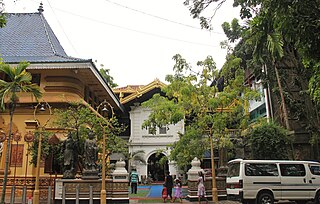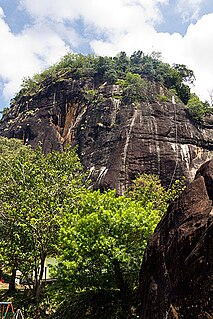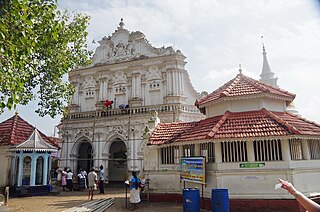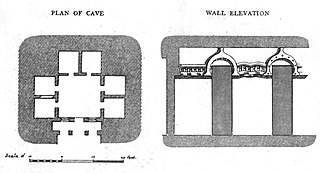
The Bodhi Tree, also known as Bo, "peepal tree", or "arasa maram" (Tamil:அரசமரம்)(Devanagari: पीपल क पेड़), was a large and ancient sacred fig tree located in Bodh Gaya, Bihar, India, under which Siddhartha Gautama, the spiritual teacher who became known as the Buddha, is said to have attained enlightenment or Bodhi. In religious iconography, the Bodhi Tree is recognizable by its heart-shaped leaves, which are usually prominently displayed.

The Maha Bodhi Society is a South Asian Buddhist society founded by the Sri Lankan Buddhist leader Anagarika Dharmapala and the British journalist and poet Sir Edwin Arnold. The organization's self-stated initial efforts were for the resuscitation of Buddhism in India, and restoring the ancient Buddhist shrines at Bodh Gaya, Sarnath and Kushinara.

Gangaramaya Temple is one of the most important temples in Colombo, Sri Lanka, being a mix of modern architecture and cultural essence.

The Kelaniya Raja Maha Vihara or Kelaniya Temple is a Buddhist temple in Kelaniya, Sri Lanka, seven miles from Colombo. The Chief Incumbent is Venerable Professor Kollupitiye Mahinda Sangharakkhitha Thera.

The Tissamaharama Raja Maha Vihara is an ancient Buddhist temple in Tissamaharama, Southern Province of Sri Lanka. It was one of the four major Buddhist monasteries established in Sri Lanka, after the arrival of Arhant Mahinda Thera to the country. The site of the Tissamaharama Raja Maha Vihara was consecrated by Lord Buddha himself, who spent some time in meditation there with 500 arhats, during his third visit to the island. Tissamaharama monastery had been recognized as a pre-eminent Buddhist educational center of the southern Sri Lanka from the 3rd century B.C. to the 11th century A.D. The Tissamaharama Dagoba which is situated in the premises of the monastery is one of the largest stupas in Sri Lanka. The present chief incumbent of Tissamaharama Raja Maha Vihara is Ven. Devalegama Dhammasena Nayaka Thera.

Seruwawila Mangala Raja Maha Vihara is an ancient Buddhist temple in Trincomalee district in Eastern Province, which is among the sixteen or seventeen holiest Buddhist shrines (Solosmasthana) in Sri Lanka.

Muhudu Maha Vihara is a Buddhist temple situated at Pottuvil in Ampara District, Eastern province of Sri Lanka. This temple which is situated near a wide beach, has been built over 2000 years ago by King Kavan Tissa of Ruhuna. Currently the ruins and remains of ancient stupas, Seema Malaka, Avasa Geya and statues can be seen at the site. Important ruins at the temple premises include stone statues of lord Buddha and two statues of old kings or gods.

Mulkirigala Raja Maha Vihara is an ancient Buddhist temple in Mulkirigala, Sri Lanka. It has been built on a 205 m (673 ft) high natural rock, surrounded with another four rocks known as Benagala, Kondagala, Bisogala and Seelawathiegala. The temple site is located about 2 km (1.2 mi) from the Mulkirigala junction and can be reached from either Dikwella or Tangalle towns. The temple has been formally recognised by the Government as an archaeological site in Sri Lanka. The designation was declared on 8 April 1988 under the government Gazette number 501.

Naigala Rajamaha Viharaya is an ancient Buddhist temple situated in Weeraketiya, Hambantota District, Sri Lanka. It is located about 2 km (1.2 mi) away from Weeraketiya junction and 8 km (5.0 mi) from ancient Buddhist temple, Mulkirigala Raja Maha Vihara.

Kadurugoda Viharaya is an ancient Buddhist temple situated in Chunnakam, Jaffna District, Sri Lanka. The temple is located in a small hamlet called Kandarodai and it is one of the few Buddhist temples remaining in Jaffna today. Currently this temple has been declared as an archaeological site in Sri Lanka and is maintained by the Sri Lankan army.

Maligatenna Raja Maha Vihara is an ancient Cave temple which is located in Malwatuhiripitiya village, Gampaha District, Sri Lanka. The temple is located on the Gampaha - Wathurugama Road and approximately 1.6 km (0.99 mi) away from the ancient temple Pilikuththuwa Raja Maha Vihara.

Seema Malaka is a Buddhist temple in Colombo, Sri Lanka. The temple is mainly used for meditation and rest, rather than for worship. Situated in the Beira Lake, the temple was originally constructed in the late 19th century. Seema Malaka is a part of the Gangaramaya Temple and is situated few hundred meters to its east.

Gadaladenyia Vihara is an ancient Buddhist temple situated in Pilimathalawa, Kandy, Sri Lanka. It is located on Gadaladenyia Road (B116), just up from the Gadaladeniya junction of the Colombo - Kandy Road (A1), approximately 12.5 km (7.8 mi) to the west of Kandy and 3 km (1.9 mi) from the ancient buddhist temple, Lankatilaka Vihara. It is considered one of the largest rock temples in Sri Lanka.

Kasagala Raja Maha Vihara is an ancient Buddhist Temple, situated in Angunukolapelessa, Hambantota District, Sri Lanka. It is situated about 10 km (6.2 mi) away from Ranna Junction along Ranna - Weeraketiya road. The temple has been formally recognised by the Government as an archaeological site in Sri Lanka. The designation was declared on 6 June 2008 under the government Gazette number 1553.

Degaldoruwa Raja Maha Vihara is an ancient Buddhist rock temple, situated in Amunugama, Kandy, Sri Lanka. It is famous for its Kandyan Era Frescoes. The cave itself was said to have been excavated out of a rock which rises to a height of approximately 12.3 m (40 ft), and shelters the shrine room and entrance chamber.

Kande Vihara is a major Buddhist temple in Kalutara District, Sri Lanka. The temple has got its name 'Kande vihara' as it is built on top of a hill located near to Aluthgama town. The temple has been formally recognised by the Government as an archaeological site in Sri Lanka.
Buddama Raja Maha Vihara is a historic Cave temple in Buddama village, Monaragala district, Sri Lanka. Buddama is a rural village lying off Siyambalanduwa town and known as one of early settlements in the country. Currently the temple has been formally recognised by the Government as an archaeological site in Sri Lanka.

Tempita Vihara is an unique type of image house found in some Buddhist temples in Sri Lanka. Have an inimitable architecture design, Tempita Viharas were popular aspect of many Buddhist temples during the 17th-19th centuries. Construction of Tempita Vihara in or after the 20 century has been not recorded. There are more than two hundred Tempita Viharas have been identified in Sri Lanka to date. Most of the shrines are found in North Western, Sabaragamuwa, Central and Western provinces.

Dodanthale Raja Maha Vihara is an historic Buddhist temple situated in Mawanella, Kegalle District, Sri Lanka. The temple is located about 4 km (2.5 mi) away from the Mawanella town. The temple has been formally recognised by the Government as an archaeological site in Sri Lanka. The designation was declared on 10 November 1978 under the government Gazette number 10.
Asgiri Maha Viharaya is a Buddhist monastery located in Kandy, Sri Lanka. It is the headquarters of the Asgiriya chapter of Siyam Nikaya, one of the two Buddhist monasteries that holds the custodianship of sacred tooth relic of Lord Buddha kept in Sri Dalada Maligawa, Kandy. The chief incumbent of the Asgiri Maha Viharaya is the Mahanayaka thero of Asgiri chapter of Siyam nikaya, a leading Buddhist monastic fraternity in Sri Lanka. The present chief incumbent of Asgiri Maha Viharaya is venrable Warakagoda Sri Gnanarathana Thero. Asgiri Maha Vihara traces its origin from the wanavasi sect of the Dimbulagala forest monastery of Polonnaruva. Currently 565 Buddhist temples in Sri Lanka functions under Asgiri Viharaya of Kandy.






















